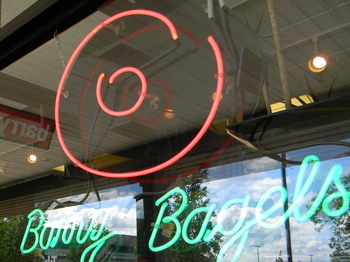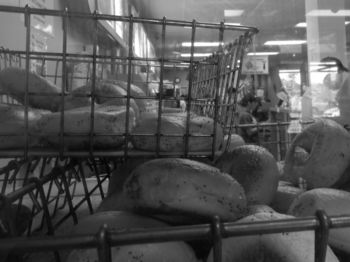Why Barry Bagels rocks: It's the dough, stupid

Jessica Levine I Contributor
Barry Greenblatt’s got a rhythm. Sleeves cuffed and apron looped, he steadily punches out bagels to the temple-numbing buzz of his mixer. He does this — like his brothers-in-arms, the pizza, burger, omelet, you-name-it makers — every day. To restaurateurs like Greenblatt, it has paid off. For 38 years, the owner of the Toledo-based chain, Barry Bagels, has made a damn good product.
Ann Arbor is glad. So is the Jackson Avenue location’s co-owner, Laura Wyraz. An Ohio native, Wyraz has been a part of Barry Bagels from its beginning. In her first and only job since high school, she, like her mentor, has slogged over thousands of egg, sesame and onion bagels.
No doubt, Wyraz gets the bagel biz. “If you get people at the beginning, treat them well and you serve a good product, they are yours forever,” she said.
The industry that began more than a century ago in the dawn of the American immigration surge has produced a permanent addendum to our culture; a tradition filled with Jewish European pride and fortitude.
For that, bagels have us forever.
Bend or bracelet
Steamers from Liverpool to Azores jostled their way into the New York City harbor. Thousands of their passengers funneled through the gates at Ellis Island, and settled in the Lower East Side of Manhattan. To make the transition to American life smoother, immigrants sought out the comforts of home. Italians brought gnocchis and fagioli. Irishmen baked soda bread and the French, baguettes.
Jews from Germany, Russia and Poland, meanwhile, prepared what was then a hard, several ounce variety of the tubular breadstuff that we have today come to toast, butter and “schmear.” Though the etymology of the word bagel is uncertain—some bagel historians argue the German biegen or “to bend” derivative, others beugel or bracelet—it is clear that the plain, salt and poppy seed flavors were popular within New York’s tenant communities. Bagel bakers slung their goods on strings and sold them in dozens on the street.
Supersize me
In his New York Times article, “Was Life Better When Bagels Were Smaller,” author Ed Levine (no relation) wrote how a group of nearly 300 bakers formed a union of bagel makers. These guys were the creators of the original New York bagel, a product much smaller and denser than its contemporaries, with a crustier crust and chewier interior.

Jessica Levine I Contributor
As Wyraz explained, tastes change. While Barry Bagels’ best sellers are plain and raisin, the newbie flavors are closing in the ranks. Its third best seller? Vanilla cinnamon. The Saturday morning favorite is chocolate chip.
What we do best
“Doughnuts are fun, with sugary smiles, sales peaking at Halloween; bagels are serious, ethnic and harder to digest,” wrote William Safire in his New York Times essay “Bagels vs. Doughnuts.”
That is how we like ‘em in Ann Arbor.
Twelve years after he established his first restaurant of five in Toledo, Greenblatt opened Barry Bagels at its location in the Westgate Shopping Center. Business is mega strong. In addition to the throngs of regular customers lining up each morning, Barry Bagels’ night crew delivers its wares to University of Michigan Hospital, St. Joseph Mercy and Espresso Royale.
Why Barry Bagels has earned the loyalty of so many, winning AnnArbor.com’s Community Choice Award for Best Place for Bagels several years running, is easy. It’s the dough, stupid.
“There are so many different styles of bread,” said Wyraz. “There’s hard bread, there’s soft bread, there’s crusty bread, there’s sourdough bread. People are really particular about bread, and when you like a certain thing, you like a certain thing. Our bagels tend to be softer and chewier, and they tend to last longer.”
Plain, sesame, onion, everything, asiago cheese, garlic, blueberry, cranberry and more. Pack those with the traditional stuff — corned beef, pastrami, turkey or chopped liver — and you have got a killer sandwich. Now, I do not fancy myself a chef by any means. Nuh-uh, I am no Bourdain, Ripert, Chang, Deen nor Giada. But when it comes to bagels and pastrami, my family has very high standards. Barry Bagels meets them.
Its interior is unassuming — a long walk-up counter, narrow dining room, and din of exchanging bagels, cash and butter knives suited for Wall Street’s opening bell. Yet, Wyraz isn’t surprised that the Levines and droves of other families, college students and white collar employees keep coming back.
“We stick with one item and do it the best,” she said.
And, for that, Barry Bagels has us forever.
Jessica Levine profiles the culture and history of Washtenaw County restaurants for AnnArbor.com. Contact her at jlfoodstuffz@gmail.com.


Comments
Aaron
Sun, Jan 9, 2011 : 2:09 a.m.
Barry's does make water bagels. If you go to the store you can watch the process. The softness on the outside results from the fact that they're pan baked as opposed to being baked with wet boards. I baked bagels during college the "wet board" way and I still lack some sensation in my fingertips - it's much easier to bake on pans and for less skilled bakers results in a lot less waste. But I have to admit I like the crust you get from baking bagels the traditional way - the pan needs to be lightly coated with something to prevent the bagels from sticking to the pans as they bake, and it's that shortening that keeps a traditional crust from forming. You can recapture the crust to a degree by toasting the bagel, but... it's not the same. Like the NYTimes Levine I also like the balance of crustiness to chewiness of a 3 oz bagel, like the ones made by Zingermans, as compared to a larger, 4 oz bagel, but thanks (presumably) to supermarket bagels people apparently expect the larger product. "Back in the day", it was my understanding that Bagel Fragel obtained its dough from the Bagel Factory. But for a licensing deal, they couldn't have used the name "Fragel" in their business name - that word was trademarked by The Bagel Factory. I don't know where they currently source their dough but I expect that Barry Greenblatt acquired the rights to the Fragel trademark when he purchased The Bagel Factory, which could mean that they're using the same dough as Barry's. It would be an interesting story, "for parity" or otherwise. Legend has it that Barry invented the Fragel back when he was a student at EMU and working at the Bagel Factory.
Jessie
Mon, Apr 25, 2011 : 10:31 p.m.
Barry's dough comes from The Bagel Factory production facility by the airport.
ShadowManager
Tue, Sep 28, 2010 : 2:05 p.m.
There needs to be an article on Bagel Fragel for parity.
DFSmith
Tue, Sep 14, 2010 : 9:16 a.m.
Agree with rob. I like the bagels sold at Bragel-Fragel on Plymouth Road on the north-east part of town. Also like Zingerman's bagels, when they are fresh- they seem to get really hard if they get to be a day old.
Rob
Tue, Sep 14, 2010 : 6:56 a.m.
A true bagel should be hard on the outside, soft on the inside. Barry Bagels are dinner rolls with holes in them. You get the effect by boiling them is salt water, which it appears Barry's doesn't do.
Juno
Tue, Sep 14, 2010 : 5:28 a.m.
You rocked this profile! Barry's is the best--no leaden, dry bagels here. It IS the dough!